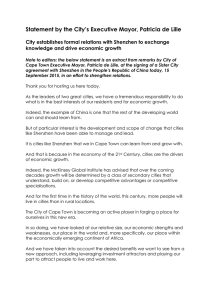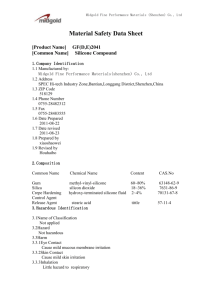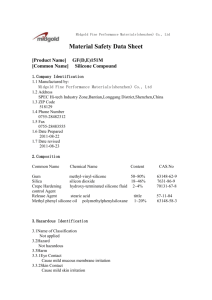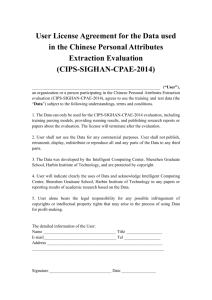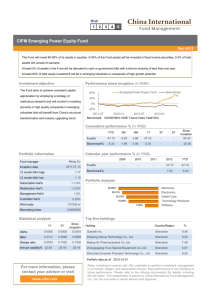Research Journal of Applied Sciences, Engineering and Technology 6(23): 4340-4343,... ISSN: 2040-7459; e-ISSN: 2040-7467
advertisement
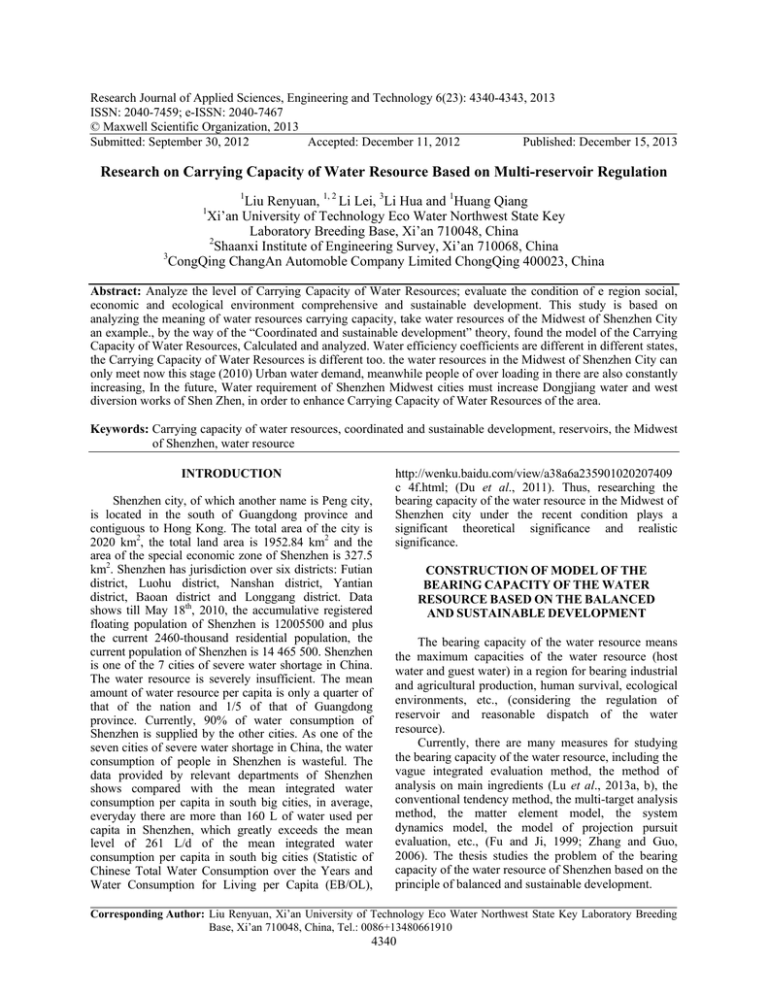
Research Journal of Applied Sciences, Engineering and Technology 6(23): 4340-4343, 2013 ISSN: 2040-7459; e-ISSN: 2040-7467 © Maxwell Scientific Organization, 2013 Submitted: September 30, 2012 Accepted: December 11, 2012 Published: December 15, 2013 Research on Carrying Capacity of Water Resource Based on Multi-reservoir Regulation 1 Liu Renyuan, 1, 2 Li Lei, 3Li Hua and 1Huang Qiang Xi’an University of Technology Eco Water Northwest State Key Laboratory Breeding Base, Xi’an 710048, China 2 Shaanxi Institute of Engineering Survey, Xi’an 710068, China 3 CongQing ChangAn Automoble Company Limited ChongQing 400023, China 1 Abstract: Analyze the level of Carrying Capacity of Water Resources; evaluate the condition of e region social, economic and ecological environment comprehensive and sustainable development. This study is based on analyzing the meaning of water resources carrying capacity, take water resources of the Midwest of Shenzhen City an example., by the way of the “Coordinated and sustainable development” theory, found the model of the Carrying Capacity of Water Resources, Calculated and analyzed. Water efficiency coefficients are different in different states, the Carrying Capacity of Water Resources is different too. the water resources in the Midwest of Shenzhen City can only meet now this stage (2010) Urban water demand, meanwhile people of over loading in there are also constantly increasing, In the future, Water requirement of Shenzhen Midwest cities must increase Dongjiang water and west diversion works of Shen Zhen, in order to enhance Carrying Capacity of Water Resources of the area. Keywords: Carrying capacity of water resources, coordinated and sustainable development, reservoirs, the Midwest of Shenzhen, water resource INTRODUCTION Shenzhen city, of which another name is Peng city, is located in the south of Guangdong province and contiguous to Hong Kong. The total area of the city is 2020 km2, the total land area is 1952.84 km2 and the area of the special economic zone of Shenzhen is 327.5 km2. Shenzhen has jurisdiction over six districts: Futian district, Luohu district, Nanshan district, Yantian district, Baoan district and Longgang district. Data shows till May 18th, 2010, the accumulative registered floating population of Shenzhen is 12005500 and plus the current 2460-thousand residential population, the current population of Shenzhen is 14 465 500. Shenzhen is one of the 7 cities of severe water shortage in China. The water resource is severely insufficient. The mean amount of water resource per capita is only a quarter of that of the nation and 1/5 of that of Guangdong province. Currently, 90% of water consumption of Shenzhen is supplied by the other cities. As one of the seven cities of severe water shortage in China, the water consumption of people in Shenzhen is wasteful. The data provided by relevant departments of Shenzhen shows compared with the mean integrated water consumption per capita in south big cities, in average, everyday there are more than 160 L of water used per capita in Shenzhen, which greatly exceeds the mean level of 261 L/d of the mean integrated water consumption per capita in south big cities (Statistic of Chinese Total Water Consumption over the Years and Water Consumption for Living per Capita (EB/OL), http://wenku.baidu.com/view/a38a6a235901020207409 c 4f.html; (Du et al., 2011). Thus, researching the bearing capacity of the water resource in the Midwest of Shenzhen city under the recent condition plays a significant theoretical significance and realistic significance. CONSTRUCTION OF MODEL OF THE BEARING CAPACITY OF THE WATER RESOURCE BASED ON THE BALANCED AND SUSTAINABLE DEVELOPMENT The bearing capacity of the water resource means the maximum capacities of the water resource (host water and guest water) in a region for bearing industrial and agricultural production, human survival, ecological environments, etc., (considering the regulation of reservoir and reasonable dispatch of the water resource). Currently, there are many measures for studying the bearing capacity of the water resource, including the vague integrated evaluation method, the method of analysis on main ingredients (Lu et al., 2013a, b), the conventional tendency method, the multi-target analysis method, the matter element model, the system dynamics model, the model of projection pursuit evaluation, etc., (Fu and Ji, 1999; Zhang and Guo, 2006). The thesis studies the problem of the bearing capacity of the water resource of Shenzhen based on the principle of balanced and sustainable development. Corresponding Author: Liu Renyuan, Xi’an University of Technology Eco Water Northwest State Key Laboratory Breeding Base, Xi’an 710048, China, Tel.: 0086+13480661910 4340 Res. J. App. Sci. Eng. Technol., 6(23): 4340-4343, 2013 The principle of the balanced and sustainable development is: try best to increase the utilization rate of the water resource, reduce the loss of the water resource and realize the development mode of unification of economy, society and ecology. Thus, the thesis discusses the concept of the coefficient of water utilizing efficacy. The coefficient of water utilizing efficacy reflects the utilizing degree of the water resource used by a region or a water utilizing department and also can reflect the economic level of the region. The model of balanced and sustainable development is divided into five steps: • • • • • • Confirm the capacity of reservoir V/m3 Confirm the available amount or water supplying amount W (g) /m3 of the water resource of the city. Confirm the integrated quantity of demand of the city r/m3. Solve the integrated water-utilization efficacy coefficient U[7] of the city. Solve the GDP of the city G/RMB Establish the model of balanced and sustainable development: Target function: n n MinWg = ∑∑ (W x (U (m, t ), G (m, t ),V (m, t ))) m =1 t =1 (1) W U W1U 1 W2U 2 = = ........ = N n r1 r2 rn (2) G G G1 G2 = = = ........... = n W W1 W2 Wn (3) n m =1 n ∑W m =1 n g (m) ≤ ∑ WEx - warehouse (m) m =1 m =1 Ex - warehouse ( m) W = W1 + W2 + ..... + Wn (5) In the equation, r j (j = 1, 2, …, n) : The amount/m3 of water demanded by the city of the j aspect under a level of living The water supplying W j (j = 1, 2, …, n) : amount/m3 corresponding to the j demand of every area of the city U j (j = 1, 2, …, n) : The maximum production capacity of the unit water resource amount on a water utilizing target j (such as GDP), i.e., the water-utilization efficacy coefficient, U decides the water-utilization efficiency, the higher the U value is, the higher the water-utilization level is G j (j = 1, 2, …n) : The total output value/RMB and the level of economic development of the area can be shown by the total output value W EX-warehouse (m), Q g (m), Q EX-warehouse (m), respectively represents the inlet flow, outlet water amount, water supplying flow, outlet flow/m3 of the reservoir m; W g (), W x () represents the supplied water of reservoir and the demanded water of city/m3. 𝑉𝑉𝑚𝑚𝑚𝑚𝑚𝑚𝑚𝑚 (𝑡𝑡), 𝑣𝑣𝑚𝑚𝑚𝑚𝑚𝑚𝑚𝑚 (𝑡𝑡) are the limitations of the maximum and minimum reservoir storage of the reservoir m at t time. ESTIMATION AND EVALUATION OF THE BEARING CAPACITY OF THE WATER RESOURCE IN THE MIDWEST OF SHENZHEN Vm (t + 1) = Vm (t ) Constraint conditions: g Vmmin ( t ) ≤ Vm (t ) ≤ Vmmax (t ) Transfer equation of the status of reservoir: + WIn - warehouse (t ) − WEx - warehouse (t ) n ∑ Q ( m) ≤ ∑ Q (4) Overview of the research area: The thesis takes the Midwest of Shenzhen as the target, wherein it includes Baoan, Nanshan and Futian districts, of which the areas are respectively 79, 151 and 733 km2, the total area is 963 km2. Till 2010, the total population of Futian, Baoan and Nanshan districts is 7183300 (Bulletin of Statistic of National Economy and Social Development of Table 1: Rainfall of Shi Yan hydrological station from 1970 to 2005 unit: mm Year 1970 1971 1972 1973 Rainfall 1666.5 1810.1 1836.0 2000.6 Year 1978 1979 1980 1981 Rainfall 1575.8 1518.1 1488.9 1520.7 Year 1986 1987 1988 1989 Rainfall 1563.2 1828.4 1272.3 1250.4 Year 1994 1995 1996 1997 Rainfall 1903.0 1463.2 1662.0 1739.0 Year 2002 2003 2004 2005 Rainfall 1417.5 1419.1 1431.5 1824.4 4341 1974 1975 1576.8 2382.4 1982 1983 1376.8 1810.9 1990 1991 1021.0 1021.4 1998 1999 1548.9 1495.8 Multi-year mean value 1615.57 1976 1872.1 1984 1060.7 1992 1643.1 2000 2160.2 1977 1151.9 1985 1608.5 1993 1930.7 2001 2308.7 Res. J. App. Sci. Eng. Technol., 6(23): 4340-4343, 2013 Table 2: The local average years input supply unit: 108 m3 Local selfName production water Gongming reservoir 0 Ejing reservoir 0.0260 Shiyan reservoir 0.1674 Xikeng reservoir 0.0198 Total 0.2132 water and the scale of water Scale of the corresponding waterworks for water supply 0 0.546 2.179 0.988 3.713 Shenzhen City in 2000, 2005 and 2010, http://news.sznews. com/content/2011-04/25/content_ 5565662. htm). Main water resources of the Midwest of Shenzhen are self-production water and water supplied from other places. The proportion of the water supplied from other places is about 90% of the total amount of the fresh water used in the special area. Local water: To the local water, it mainly takes the rainfall data from 1970 to 2005 of the Shiyan hydrologic station, Shenzhen (Xu and Chen, 2008) as the rainfall of the whole region: the multi-year mean rainfall is 1615.57 mm; the mean value per month is 133.1 mm; it is shown in Table 1. According to the multi-year rainfall data, the self-production water of all reservoirs in the Midwest of Shenzhen city is obtained and it is shown in Table 2. The self-production water of the Gongming reservoir and the loss of pervaporation are basically cancelled out and the Gongming reservoir is a spare reservoir without the corresponding waterworks, thus, the scale of water supply of the self-production water and the corresponding waterworks is calculated as zero. Water from other areas: Recently, the water supplying project of the northern line is mainly used for supplying the water from other areas to the Midwest of Shenzhen. Under the 97% guarantee rate of water supply, the water supplying amount of the northern line is 350-million m3/year. In future, the amount of the water supplied by the northern line should be increased and the water supplying project in the western line should be combined for water supply. Amount of water demand of the city: To the sum of the amount of current (2010 year) water demand of all departments of cities in the Midwest of Shenzhen, it should take the water supply scale of the waterworks corresponding to each reservoir as the final and the sum is 371.3-million m3/year (Table 2). According to the current demand of water consumption, carry out the long-series united optimal dispatch calculation to the reservoir group through the Eq. (4) and (5) in the model of balanced and sustainable development, they are multi-year reservoirs which store the residual water in the ample flow year and supply water to the city in the dry year. The balance relationship between supply and demand of the water resource is obtained and results are shown in Table 3. The multi-year mean total amount of water supply of the Midwest of Shenzhen from 1970 to 2005 is 37.13million m3. As the water demand amount of 37.13million m3 of the city in 2010, the actual multi-year mean amount of water supply is 37.13-million m3. It can be concluded that the current amount of water supply can satisfy the demand of water consumption of 2010. The result is shown in Table 3. U vale means the local total production value/corresponding water consumption. The higher the U value is, the richer the city is and it is shown in Table 4. Table 5 is the result of the analysis on the loading capacity of the water resource in Shenzhen. Table 3: The calculated results of long series water resources supply and requirement balance of the Midwest of ShenZhen city unit: 108m3 Corresponding Water Amount of Surplus and V capacity Serial Self-production Total volume of Sequence year demand water supply deficiency of reservoir number Year water water supply (increase) 1 1970 0.215 3.715 3.778 1999 3.713 3.713 0.065 0.065 2 1971 0.222 3.722 3.776 1982 3.713 3.713 0.063 0.128 3 1972 0.226 3.726 3.764 1977 3.713 3.713 0.051 0.179 4 1973 0.225 3.725 3.761 1991 3.713 3.713 0.048 0.227 5 1974 0.219 3.719 3.745 1986 3.713 3.713 0.032 0.259 … … … … … … … … … … 31 2000 0.167 3.667 3.679 1998 3.713 3.713 -0.034 0.260 32 2001 0.204 3.704 3.678 1980 3.713 3.713 -0.035 0.225 33 2002 0.230 3.730 3.674 1985 3.713 3.713 -0.039 0.186 34 2003 0.235 3.735 3.667 2000 3.713 3.713 -0.046 0.140 35 2004 0.188 3.688 3.657 1983 3.713 3.713 -0.056 0.084 36 2005 0.193 3.693 3.635 1990 3.713 3.713 -0.078 0.006 Average 0.213 3.713 3.713 3.713 3.713 0.000 0.006 Table 4: The efficiency coefficient of water in Midwest of Shenzhen city 2000-subsistence type 2005-full well-off type --------------------------------------------------- -----------------------------------------------------First Second Third First Second Third industry industry industry industry industry industry Type Baoan 0.632 20.388 10.5890 0.511 73.5670 46.3020 Nanshan 0.079 23.606 7.3250 0.250 66.2800 29.4900 Futian 0.006 13.375 15.1200 0.001 20.5750 44.5610 Total 0.717 57.369 33.0340 0.759 160.4190 120.3510 4342 2010-initial rich type ----------------------------------------------First Second Third industry industry industry 0.051 96.4410 51.6780 0.085 102.2900 59.6870 169.2740 0.071 20.2670 0.208 218.9980 280.6390 Res. J. App. Sci. Eng. Technol., 6(23): 4340-4343, 2013 Table 5: Carrying capacity of water resources in Shenzhen[7.10] unit: E-108 Yuan, P-104 (Jiao, 2007; Liu et al., 2008) Type ------------------------------------------------------------------------------------------------------------------------------------------------------2000-subsistence type 2005-full well-off type 2010-initial rich type --------------------------------------------------- ----------------------------------------------------- ------------------------------------------Name Economy Population Economy Population Economy Population Baoan 305.490 165.69 1163.45 204.17 2329.84 362.01 Nanshan 364.080 123.72 1124.66 152.45 1990.05 270.31 Futian 448.070 101.85 1027.03 125.50 1832.63 222.52 Total 1117.640 391.25 3315.14 482.11 6152.52 854.84 Under the subsistence condition, basically, Baoan district, Futian district and Nanshan district are in the status of loading insufficiency. Under the condition of the full well-off type, Futian district and Nanshan district are little overload and Baoshan district is highly overload and the overload value is about 1278600 persons. Under the condition of initial rich type, Futian and Nanshan are basically little overloading, Baoan district is highly overload and the overload value is about 1380000 persons. • • CONCLUSION AND DISCUSSION The model of balanced and sustainable development established by the thesis analyzes and calculates out the conditions of the bearing capacity of water resources of subsistence type, full well-off type and initial rich type in Futian district, Nanshan district and Baoan district in the Midwest of Shenzhen. Results show the following: in the target year, the amount of the water resource in the Midwest of Shenzhen at most can satisfy the requirements of water consumption of initial rich type at present (2010 year) and the status of balance of supply and demand can be satisfied without water insufficiency and meanwhile, the overload population of each district also continuously increases. In the dry year, the population of the bearing capacity in the Midwest of Shenzhen will be definitely smaller than that of the target year, thus, the stability of the water consumption in the Midwest of Shenzhen is conserved. The thesis proposes the following advices: • • • Creating the city of water saving type, try best to develop and utilize the new water resource and develop the water saving technology, establish the well running system of water supply, recycling of intermediate water and sewage processing and increase the utilization ratio of the water resource. Establish and perfect the management system of the development and utilization of the water resource, get the sustainable development of the water resource and provide sustainable and reliable water resource for the economic development and people’s living of Shenzhen. The water used by the Midwest of Shenzhen mainly depends on the water of the Dongjiang River, so to prevent emergency incidents in Shenzhen; Shenzhen should prepare well form the emergent water supply plan of the reserve reservoir. To satisfy the requirement of long-term (2020) water supply, it must increase the supplying amount of the water from the Dongjiang River and be combined with the water supplying project in the western line for water supply. For the data is limited, the thesis does not consider the problem of the bearing capacity of the water resource from the aspect of the water environment pollution, thus, this should be improved. REFERENCES Du, M. et al., 2011. Evaluation and analysis on the bearing capacity of water resources in Jining City [J]. J. Univ., Jinan Nat. Sci. Edn., 25(4): 341-343. Fu, X. and C. Ji, 1999. Integrated evaluation of bearing capacity of regional water resources: Application of analysis technique of main ingredients [J]. Resour. Environ. Watershed Yangtse River, 8(2): 168-172. Jiao, S., 2007. Study on the bearing capacity of the current water resource in Anyang City [J]. Protect. Water Resour., 23(2): 47-49. Liu, B. et al., 2008. Quantitative analysis on the bearing capacity of the water resource in Nantong City [J]. Anhui Agric. Sci. Technol., 2008: 3-9. Lu, S.B., X. Bai and W.G. Liao, 2013a. Risk analysis on hydraulic engineering construction [J]. Environ. Eng. Manag. J., 2(12). Lu, S.B., X. Bai and W.G. Liao, 2013b. Evaluation and analysis of sustainable utilization of water resource based on entropy weight set pair theory [J]. Energ. Educ. Sci. Technol. A., 30(2). Xu, J. and H. Chen, 2008. Report of preliminary design of gongming water supply project of Shenzhen City (Part of integrated introduction edition 2) [R]. Shenzhen Water Planning and Designing Institute, 2008: 3-9. Zhang, B. and F. Guo, 2006. Statement of study on the bearing capacities of water resources at home and abroad [J]. Shanghai Econ. Rev., 10: 39-42. 4343


